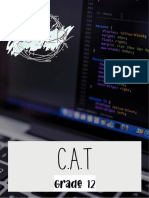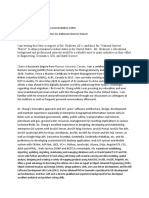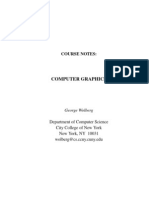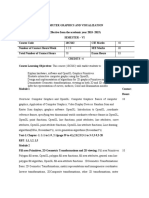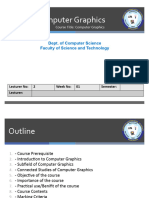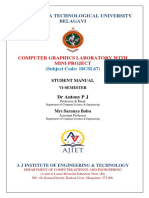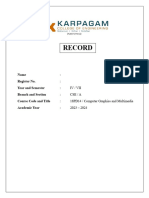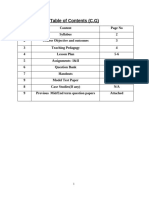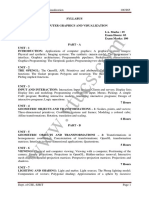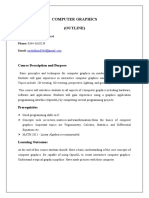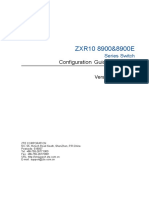Professional Documents
Culture Documents
CG Syllabus
CG Syllabus
Uploaded by
SHANKAR R Cse0 ratings0% found this document useful (0 votes)
26 views2 pagesThis document outlines a course on Computer Graphics and Visualization that uses the OpenGL graphics library. The course has 5 modules that cover topics like 2D and 3D graphics primitives, geometric transformations, illumination models, visible surface detection, curves and animation. Students will learn to design and implement 2D graphics algorithms, apply geometric transformations, perform clipping and viewing transformations, and develop graphics using OpenGL. The course aims to explain hardware, software, and OpenGL primitives and enable students to illustrate interactive graphics using OpenGL. Assessment includes a 3-hour exam with 10 questions, 5 of which must be answered in full from each module.
Original Description:
Original Title
CG syllabus
Copyright
© © All Rights Reserved
Available Formats
PDF, TXT or read online from Scribd
Share this document
Did you find this document useful?
Is this content inappropriate?
Report this DocumentThis document outlines a course on Computer Graphics and Visualization that uses the OpenGL graphics library. The course has 5 modules that cover topics like 2D and 3D graphics primitives, geometric transformations, illumination models, visible surface detection, curves and animation. Students will learn to design and implement 2D graphics algorithms, apply geometric transformations, perform clipping and viewing transformations, and develop graphics using OpenGL. The course aims to explain hardware, software, and OpenGL primitives and enable students to illustrate interactive graphics using OpenGL. Assessment includes a 3-hour exam with 10 questions, 5 of which must be answered in full from each module.
Copyright:
© All Rights Reserved
Available Formats
Download as PDF, TXT or read online from Scribd
Download as pdf or txt
0 ratings0% found this document useful (0 votes)
26 views2 pagesCG Syllabus
CG Syllabus
Uploaded by
SHANKAR R CseThis document outlines a course on Computer Graphics and Visualization that uses the OpenGL graphics library. The course has 5 modules that cover topics like 2D and 3D graphics primitives, geometric transformations, illumination models, visible surface detection, curves and animation. Students will learn to design and implement 2D graphics algorithms, apply geometric transformations, perform clipping and viewing transformations, and develop graphics using OpenGL. The course aims to explain hardware, software, and OpenGL primitives and enable students to illustrate interactive graphics using OpenGL. Assessment includes a 3-hour exam with 10 questions, 5 of which must be answered in full from each module.
Copyright:
© All Rights Reserved
Available Formats
Download as PDF, TXT or read online from Scribd
Download as pdf or txt
You are on page 1of 2
COMPUTER GRAPHICS AND VISUALIZATION
[As per Choice Based Credit System (CBCS) scheme]
(Effective from the academic year 2016 -2017)
SEMESTER – VI
Subject Code 15CS62 IA Marks 20
Number of Lecture Hours/Week 4 Exam Marks 80
Total Number of Lecture Hours 50 Exam Hours 03
CREDITS – 04
Course objectives: This course will enable students to
• Explain hardware, software and OpenGL Graphics Primitives.
• Illustrate interactive computer graphic using the OpenGL.
• Design and implementation of algorithms for 2D graphics Primitives and attributes.
• Demonstrate Geometric transformations, viewing on both 2D and 3D objects.
• Infer the representation of curves, surfaces, Color and Illumination models
Module – 1 Teaching
Hours
Overview: Computer Graphics and OpenGL: Computer Graphics:Basics of 10 Hours
computer graphics, Application of Computer Graphics, Video Display Devices:
Random Scan and Raster Scan displays, color CRT monitors, Flat panel displays.
Raster-scan systems: video controller, raster scan Display processor, graphics
workstations and viewing systems, Input devices, graphics networks, graphics on
the internet, graphics software. OpenGL: Introduction to OpenGL ,coordinate
reference frames, specifying two-dimensional world coordinate reference frames
in OpenGL, OpenGL point functions, OpenGL line functions, point attributes,
line attributes, curve attributes, OpenGL point attribute functions, OpenGL line
attribute functions, Line drawing algorithms(DDA, Bresenham’s), circle
generation algorithms (Bresenham’s).
Text-1:Chapter -1: 1-1 to 1-9,2-1 to 2-9 (Excluding 2-5),3-1 to 3-5,3-9,3-20
Module – 2
Fill area Primitives, 2D Geometric Transformations and 2D viewing: Fill 10 Hours
area Primitives: Polygon fill-areas, OpenGL polygon fill area functions, fill area
attributes, general scan line polygon fill algorithm, OpenGL fill-area attribute
functions. 2DGeometric Transformations: Basic 2D Geometric Transformations,
matrix representations and homogeneous coordinates. Inverse transformations,
2DComposite transformations, other 2D transformations, raster methods for
geometric transformations, OpenGL raster transformations, OpenGL geometric
transformations function, 2D viewing: 2D viewing pipeline, OpenGL 2D viewing
functions.
Text-1:Chapter 3-14 to 3-16,4-9,4-10,4-14,5-1 to 5-7,5-17,6-1,6-4
Module – 3
Clipping,3D Geometric Transformations, Color and Illumination Models: 10 Hours
Clipping: clipping window, normalization and viewport transformations, clipping
algorithms,2D point clipping, 2D line clipping algorithms: cohen-sutherland line
clipping only -polygon fill area clipping: Sutherland-Hodgeman polygon clipping
algorithm only.3DGeometric Transformations: 3D translation, rotation, scaling,
composite 3D transformations, other 3D transformations, affine transformations,
OpenGL geometric transformations functions. Color Models: Properties of light,
color models, RGB and CMY color models. Illumination Models: Light sources,
basic illumination models-Ambient light, diffuse reflection, specular and phong
model, Corresponding openGL functions.
Text-1:Chapter :6-2 to 6-08 (Excluding 6-4),5-9 to 5-17(Excluding 5-15),12-
1,12-2,12-4,12-6,10-1,10-3
Module – 4
3D Viewing and Visible Surface Detection: 3DViewing:3D viewing concepts, 10 Hours
3D viewing pipeline, 3D viewing coordinate parameters , Transformation from
world to viewing coordinates, Projection transformation, orthogonal projections,
perspective projections, The viewport transformation and 3D screen coordinates.
OpenGL 3D viewing functions. Visible Surface Detection Methods:
Classification of visible surface Detection algorithms, back face detection, depth
buffer method and OpenGL visibility detection functions.
Text-1:Chapter: 7-1 to 7-10(Excluding 7-7), 9-1 to 9-3, 9-14
Module – 5
Input& interaction, Curves and Computer Animation: Input and Interaction: 10 Hours
Input devices, clients and servers, Display Lists, Display Lists and Modelling,
Programming Event Driven Input, Menus Picking, Building Interactive Models,
Animating Interactive programs, Design of Interactive programs, Logic
operations .Curved surfaces, quadric surfaces, OpenGL Quadric-Surface and
Cubic-Surface Functions, Bezier Spline Curves, Bezier surfaces, OpenGL curve
functions. Corresponding openGL functions.
Text-1:Chapter :8-3 to 8-6 (Excluding 8-5),8-9,8-10,8-11,3-8,8-18,13-11,3-
2,13-3,13-4,13-10
Text-2:Chapter 3: 3-1 to 3.11: Input& interaction
Course outcomes: The students should be able to:
• Design and implement algorithms for 2D graphics primitives and attributes.
• Illustrate Geometric transformations on both 2D and 3D objects.
• Apply concepts of clipping and visible surface detection in 2D and 3D viewing, and
Illumination Models.
• Decide suitable hardware and software for developing graphics packages using
OpenGL.
Question paper pattern:
The question paper will have TEN questions.
There will be TWO questions from each module.
Each question will have questions covering all the topics under a module.
The students will have to answer FIVE full questions, selecting ONE full question from each
module.
Text Books:
1. Donald Hearn & Pauline Baker: Computer Graphics with OpenGL Version,3rd / 4th
Edition, Pearson Education,2011
2. Edward Angel: Interactive Computer Graphics- A Top Down approach with OpenGL,
5th edition. Pearson Education, 2008
Reference Books:
1. James D Foley, Andries Van Dam, Steven K Feiner, John F Huges Computer graphics
with OpenGL: pearson education
2. Xiang, Plastock : Computer Graphics , sham’s outline series, 2nd edition, TMG.
3. Kelvin Sung, Peter Shirley, steven Baer : Interactive Computer Graphics, concepts
and applications, Cengage Learning
4. M M Raiker, Computer Graphics using OpenGL, Filip learning/Elsevier
You might also like
- C.a.T Grade 12 SummariesDocument133 pagesC.a.T Grade 12 SummariesKoketso Lion100% (1)
- Reference Letter:: Ryerson University, CanadaDocument2 pagesReference Letter:: Ryerson University, CanadaMahnoor RehmanNo ratings yet
- CSC 472Document151 pagesCSC 472Han LinNo ratings yet
- Bada OsDocument31 pagesBada OsrajoriavishalNo ratings yet
- SBT ReferenceDocument479 pagesSBT ReferenceckNo ratings yet
- CG SyllabusDocument4 pagesCG SyllabusvijetaNo ratings yet
- Cse 6TH Sem SyllabusDocument9 pagesCse 6TH Sem SyllabusCHETHAN NVNo ratings yet
- VTU S6 SyllabusDocument37 pagesVTU S6 SyllabusAppu ManjeshNo ratings yet
- SyllabusDocument19 pagesSyllabusbgbdbdfNo ratings yet
- Syllabus 6th Sem 21cs63Document7 pagesSyllabus 6th Sem 21cs63Anil JamkhandiNo ratings yet
- MicroDocument4 pagesMicroRajesh KannaNo ratings yet
- EE-321 CAD&Sim CourseOutlineDocument2 pagesEE-321 CAD&Sim CourseOutlineAimal KhanNo ratings yet
- CG Module-1Document66 pagesCG Module-1Kavyashree S KNo ratings yet
- 2 21cst602-CgipDocument4 pages2 21cst602-Cgipvarshithaga3052003No ratings yet
- CG Module-1Document66 pagesCG Module-1SpiderNo ratings yet
- Silver Oak University: College of TechnologyDocument4 pagesSilver Oak University: College of Technologykgajjar336No ratings yet
- Computer Graphics SyllabusDocument4 pagesComputer Graphics SyllabusIshika SinghalNo ratings yet
- 23 - 24introduction Lecture of CGDocument14 pages23 - 24introduction Lecture of CGJinia S.No ratings yet
- Cssyll 88 91Document4 pagesCssyll 88 91thamaraiselvi46No ratings yet
- Visvesvaraya Technological University Belagavi: Computer Graphics Laboratory With Mini ProjectDocument21 pagesVisvesvaraya Technological University Belagavi: Computer Graphics Laboratory With Mini ProjectPushpakar L SNo ratings yet
- CG SyllabusDocument2 pagesCG SyllabusAkansha SharmaNo ratings yet
- CGMT Unit5Document14 pagesCGMT Unit5premb4372No ratings yet
- CGMT Unit3Document32 pagesCGMT Unit3premb4372No ratings yet
- 2IV60 IntroDocument57 pages2IV60 IntroCecelia YumnamNo ratings yet
- Week # 01 (Lecture 1 & 2) : Computer Graphics (CS-575)Document6 pagesWeek # 01 (Lecture 1 & 2) : Computer Graphics (CS-575)naveed juttNo ratings yet
- Computer Graphics SyllabusDocument4 pagesComputer Graphics SyllabusRajput RishavNo ratings yet
- HHE 302 - Computer Graphics Course OutlineDocument4 pagesHHE 302 - Computer Graphics Course Outlinekundaichitungo23No ratings yet
- Computer Graphics Quantum-1Document246 pagesComputer Graphics Quantum-1youtenger tubeNo ratings yet
- CG Lesson Plan RoughDocument5 pagesCG Lesson Plan RoughPragathhi YvsNo ratings yet
- CG Lab Manual - 18 SchemeDocument44 pagesCG Lab Manual - 18 Schemepraveen ps100% (2)
- CSE3016 Computer-Graphics-and-Multimedia ETH 1 AC44Document3 pagesCSE3016 Computer-Graphics-and-Multimedia ETH 1 AC44;(No ratings yet
- Gujarat Technological University: Computer Engineering (07) SUBJECT CODE: 2160703Document3 pagesGujarat Technological University: Computer Engineering (07) SUBJECT CODE: 2160703Chi HanaNo ratings yet
- CGV Lab Manual 2021-1Document51 pagesCGV Lab Manual 2021-1srinidhiNo ratings yet
- Gujarat Technological University: Page 1 of 3Document3 pagesGujarat Technological University: Page 1 of 3Lucky KhuhaNo ratings yet
- Computer Graphics and VisualisationDocument17 pagesComputer Graphics and VisualisationMuhammad Haikal RahmanNo ratings yet
- CG SyllabusDocument6 pagesCG Syllabuskopima2657No ratings yet
- BHCS 14 Computer Graphics Update AwaitedDocument5 pagesBHCS 14 Computer Graphics Update Awaitedhimanshumis2022No ratings yet
- CGA Syllabus1 2Document3 pagesCGA Syllabus1 2sinduja.cseNo ratings yet
- CGM RecordDocument68 pagesCGM Record20P108AZATH A CSEANo ratings yet
- Laboratory Manual: Computer Graphics Laboratory With Mini Project 15CSL68Document88 pagesLaboratory Manual: Computer Graphics Laboratory With Mini Project 15CSL68RanjaniNo ratings yet
- UntitledDocument242 pagesUntitledArpit PandeyNo ratings yet
- Graphics SyllabusDocument9 pagesGraphics SyllabusAdarsh RNo ratings yet
- 20CD503 - Computer Graphics and AnimationDocument2 pages20CD503 - Computer Graphics and AnimationMs. Archana U Asst. ProfessorNo ratings yet
- Cse Vi Computer Graphics and Visualization 10CS65 Notes PDFDocument97 pagesCse Vi Computer Graphics and Visualization 10CS65 Notes PDFMamatha Agowda100% (1)
- Course manual-CGDocument25 pagesCourse manual-CGls.itNo ratings yet
- Lab ManualDocument57 pagesLab ManualADITYA S NIRGUNDNo ratings yet
- Computer Graphics CourseDocument5 pagesComputer Graphics CourseHafiz ABNo ratings yet
- Karnatak Arts, Science and Commerce College Bidar: Digital Image Processing Laboratory Manual - SCP 4.1Document42 pagesKarnatak Arts, Science and Commerce College Bidar: Digital Image Processing Laboratory Manual - SCP 4.1Chandrakant PatilNo ratings yet
- The Goal of This Course Is To Provide An Introduction To The Theory and Practice of Computer GraphicsDocument4 pagesThe Goal of This Course Is To Provide An Introduction To The Theory and Practice of Computer GraphicsbandarisrinivasNo ratings yet
- Cse Vi Computer Graphics and Visualization 10cs65 NotesDocument97 pagesCse Vi Computer Graphics and Visualization 10cs65 NotesDiv Dutta100% (2)
- Presentation 1Document18 pagesPresentation 1bekemaNo ratings yet
- Cad CamDocument3 pagesCad CamKannan SreenivasanNo ratings yet
- CSC 472Document150 pagesCSC 472syedmaveedNo ratings yet
- Computer Graphics (CSC209)Document6 pagesComputer Graphics (CSC209)Bishal ShahiNo ratings yet
- Computer GraphicsDocument97 pagesComputer GraphicsNaveen A ReddyNo ratings yet
- COMPUTER GRAPHICS & Multimedia SyllabusDocument3 pagesCOMPUTER GRAPHICS & Multimedia SyllabusMayank SainiNo ratings yet
- Computer Graphics (Book)Document245 pagesComputer Graphics (Book)Birjesh RathourNo ratings yet
- CG Lab PDFDocument61 pagesCG Lab PDFanantha innanjeNo ratings yet
- Module 1Document167 pagesModule 1Akshu SushiNo ratings yet
- Lecture 01Document14 pagesLecture 01Harsh DewanganNo ratings yet
- SYLLABUSDocument2 pagesSYLLABUSArvind Raj MNo ratings yet
- Computer Graphics (Outline) : Course Description and PurposeDocument2 pagesComputer Graphics (Outline) : Course Description and PurposeMashavia AhmadNo ratings yet
- CGV - MANUAL (VTU) ReportDocument50 pagesCGV - MANUAL (VTU) ReportVibgfjjbNo ratings yet
- Schaum’s Outline of Computer Graphics 2/EFrom EverandSchaum’s Outline of Computer Graphics 2/ERating: 3.5 out of 5 stars3.5/5 (6)
- Azure Serverless SuccinctlyDocument92 pagesAzure Serverless SuccinctlyJesus FloresNo ratings yet
- Convertir Pages Web Ou Fichiers HTML Vers Fichiers PDFDocument5 pagesConvertir Pages Web Ou Fichiers HTML Vers Fichiers PDFtrash accountNo ratings yet
- NewValid Cert ExamsDocument7 pagesNewValid Cert Examscpr10143No ratings yet
- Chapter 14 Key Management and DistributionDocument40 pagesChapter 14 Key Management and DistributionNimas APNo ratings yet
- Assignment: University of Education Vehari CampusDocument7 pagesAssignment: University of Education Vehari CampusMujahid HusainNo ratings yet
- Chapter 3: Technical Writing and Technical TermsDocument11 pagesChapter 3: Technical Writing and Technical TermsBen AssouNo ratings yet
- Program Code With Output: Web Technology Lab ManualDocument6 pagesProgram Code With Output: Web Technology Lab ManualAnkit BajNo ratings yet
- Database Management SystemDocument8 pagesDatabase Management SystemlatinaNo ratings yet
- Instruction Manual: Terminals VMT9000 SeriesDocument42 pagesInstruction Manual: Terminals VMT9000 SeriesclaudiuNo ratings yet
- NC Studio V10 Glass Cutting V8Document99 pagesNC Studio V10 Glass Cutting V8Mesa Macotec1No ratings yet
- XP95A - Mini Switch Monitor ModuleDocument2 pagesXP95A - Mini Switch Monitor ModuleguilhermegomNo ratings yet
- Data Flow Diagrams (DFD)Document28 pagesData Flow Diagrams (DFD)Francis SudhakarNo ratings yet
- STUDENT RESULT MANAGEMENT SYSTEM FinalDocument46 pagesSTUDENT RESULT MANAGEMENT SYSTEM Finalmareesh manjuNo ratings yet
- Mod Menu Log - Zombie - Survival.craft.zDocument15 pagesMod Menu Log - Zombie - Survival.craft.zTimotius DimasNo ratings yet
- Ymf715e 19980521Document53 pagesYmf715e 19980521xdbmbmzifNo ratings yet
- Siklu EtherHaul Operation Administration and Maintenance Manual - EH-OPER-01 Issue7 (Apr 2016)Document164 pagesSiklu EtherHaul Operation Administration and Maintenance Manual - EH-OPER-01 Issue7 (Apr 2016)Edinson FerNo ratings yet
- Time Table For SE (2015) (Sem II) (Phase II) Mar 17 Online ExamDocument3 pagesTime Table For SE (2015) (Sem II) (Phase II) Mar 17 Online ExamNavanath DarwanteNo ratings yet
- Pearson BTEC Level 5 HND in Computing Software EngineeringDocument3 pagesPearson BTEC Level 5 HND in Computing Software EngineeringGtyNo ratings yet
- Presentation of e BankingDocument42 pagesPresentation of e BankingAasma ZafarNo ratings yet
- Steps On How To Configure Your PC42t PrinterDocument7 pagesSteps On How To Configure Your PC42t PrinterAllan Billy PerudaNo ratings yet
- Ts - 38 321v160100pDocument153 pagesTs - 38 321v160100pPrasenjit MahapatraNo ratings yet
- SJ-20110624091725-014 ZXR10 8900&8900E (V3.00.01) Series Switch Configuration Guide (Security)Document153 pagesSJ-20110624091725-014 ZXR10 8900&8900E (V3.00.01) Series Switch Configuration Guide (Security)Nishchal AgarwalNo ratings yet
- LINQ Interview QuestionsDocument32 pagesLINQ Interview Questionsborhan uddinNo ratings yet
- PCB Designing Using OrCAD CaptureDocument35 pagesPCB Designing Using OrCAD CaptureGECM85No ratings yet
- 60 Top Dreamweaver Multiple Choice Questions and AnswersDocument8 pages60 Top Dreamweaver Multiple Choice Questions and AnswersA FrancesNo ratings yet
- Raymond Sarraf SearchDocument9 pagesRaymond Sarraf SearchRaymond Sarraf100% (1)
